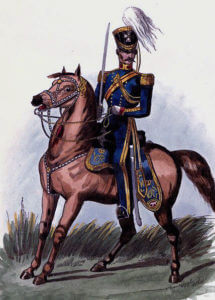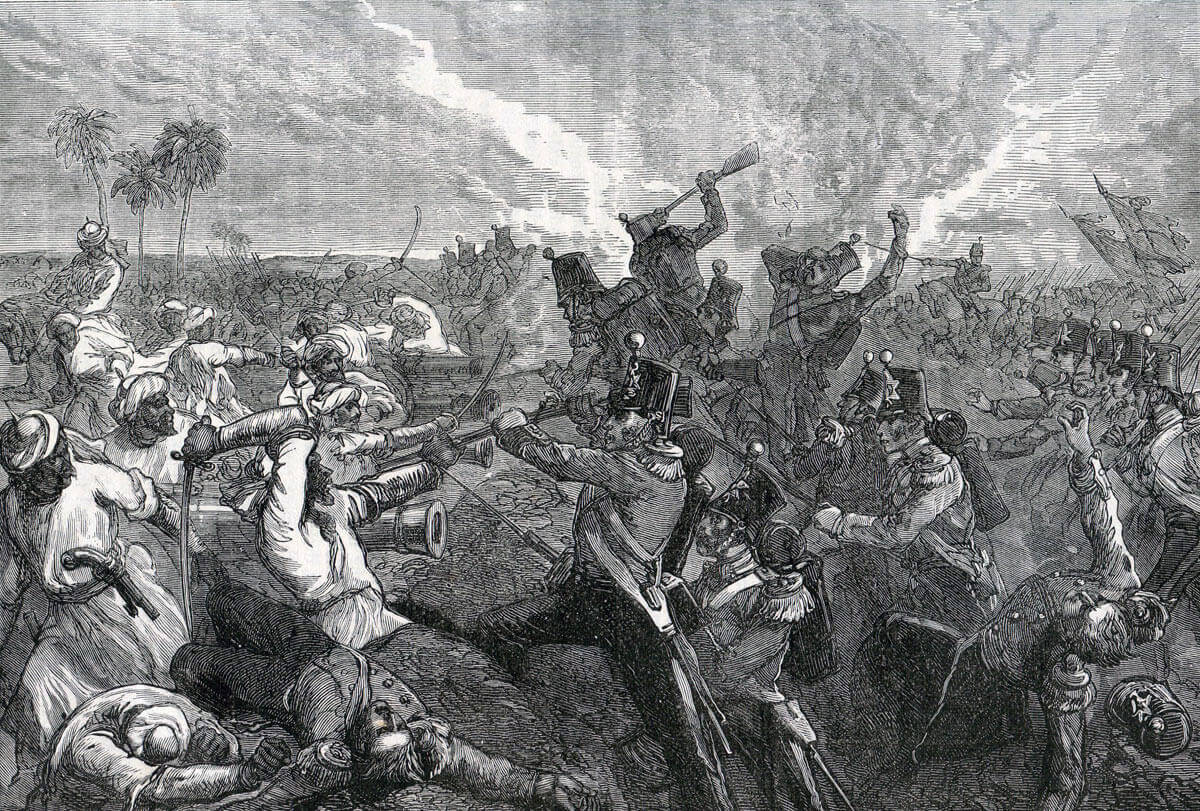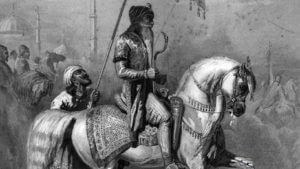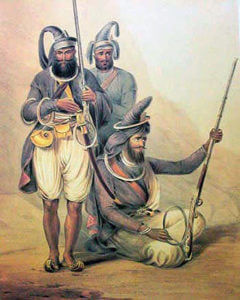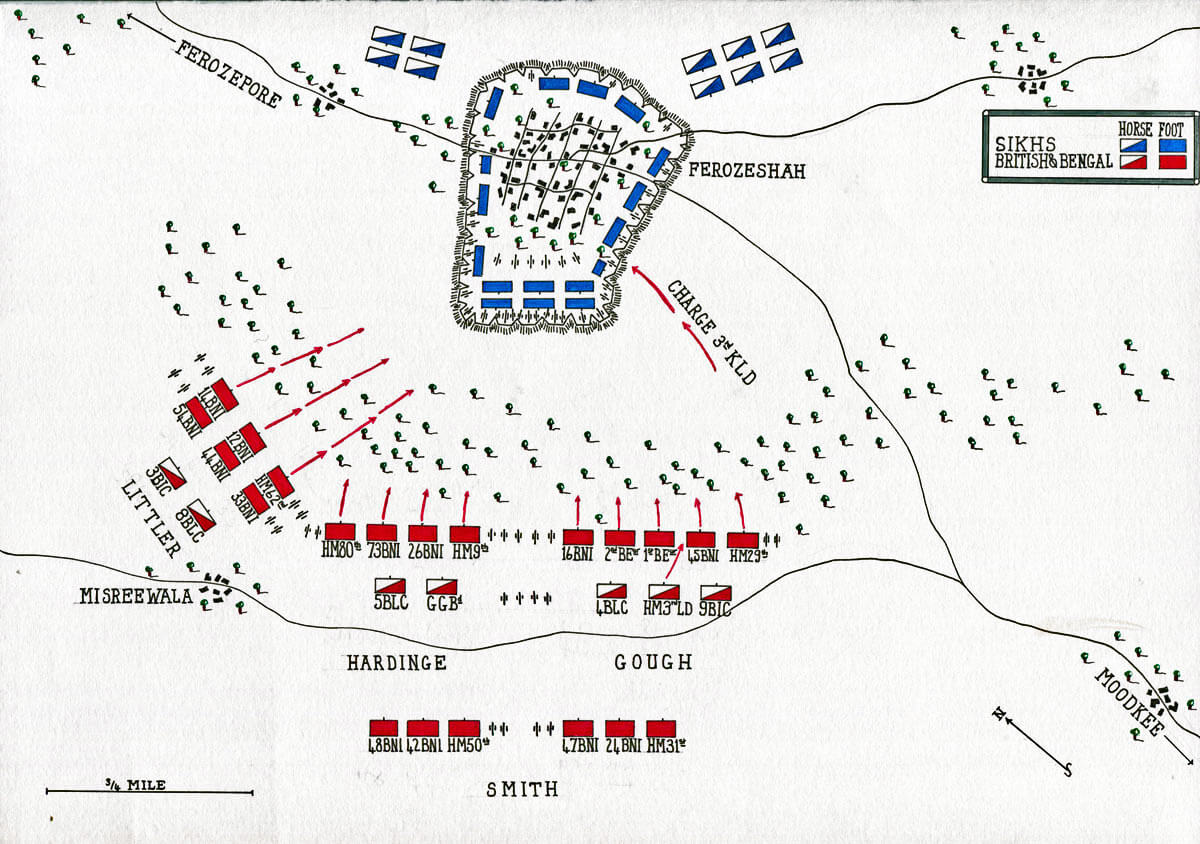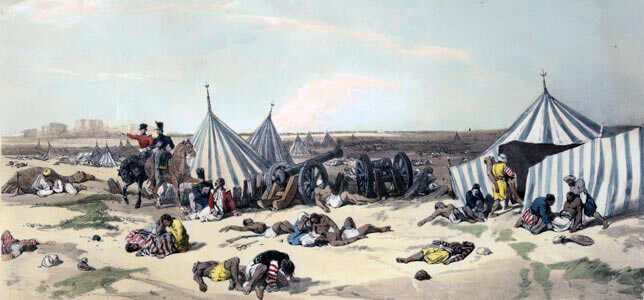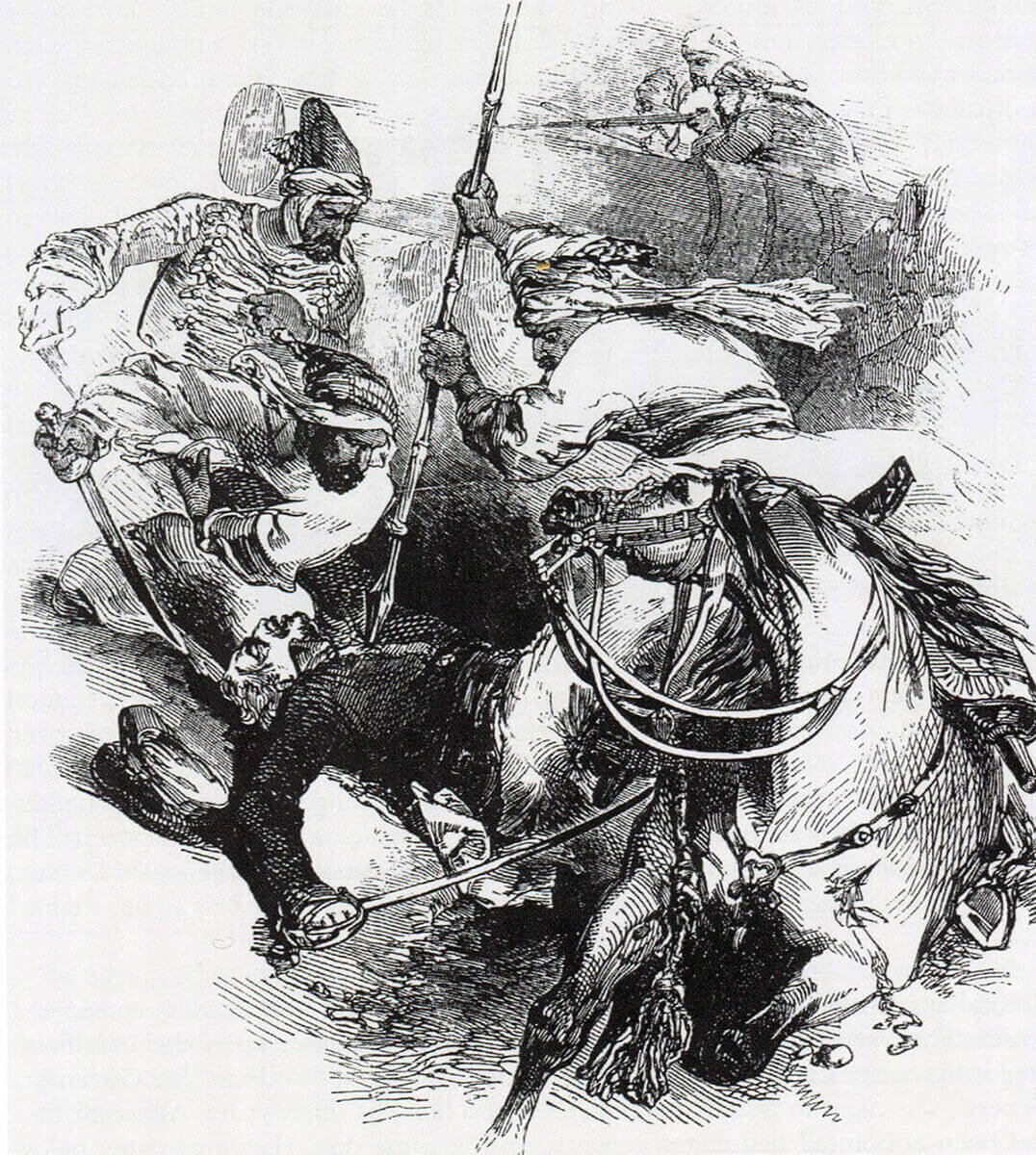The second battle of the First Sikh War: General Gough’s rash
and disorganised assault on the Sikh camp at Ferozeshah on 22nd December 1845
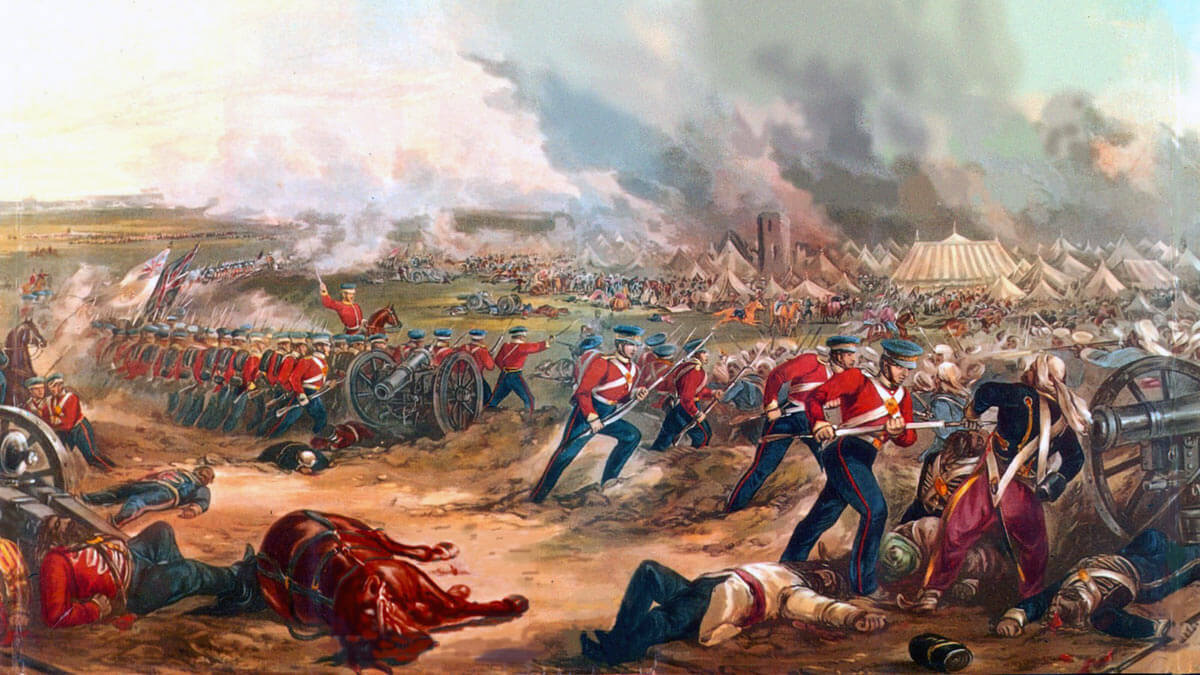
British attack the Sikh Camp at the Battle of Ferozeshah on 22nd December 1845 during the First Sikh War: picture by Maddeley
The previous battle in the First Sikh War is the Battle of Moodkee
The next battle in the First Sikh War is the Battle of Aliwal
Battle: Ferozeshah
War: First Sikh War.
Date of the Battle of Ferozeshah: 22nd December 1845.
Place of the Battle of Ferozeshah: In the Punjab in the north-west of India.
Combatants at the Battle of Ferozeshah: British troops and Indian troops of the Bengal Presidency against Sikhs of the Khalsa, the army of the Punjab.
Commanders at the Battle of Ferozeshah: Major General Sir Hugh Gough and General Sir Henry Hardinge against Lal Singh and Tej Singh.
Size of the armies at the Battle of Ferozeshah: A British and Bengal army of 18,000 men, 63 guns and 2 Howitzers against a Sikh army initially of Lal Singh’s force of 10,000 cavalry, 4,000 infantry and 22 guns, joined by Tej Singh’s troops from Ferozepore of 30,000 men and 150 guns (including many heavy calibre). The Sikh army contained a force of religious fanatics called the Akalis.
Uniforms, arms and equipment at the Battle of Ferozeshah (this section is the same in each of the battles of the Sikh Wars):
The two wars fought between 1845 and 1849 between the British and the Sikhs led to the annexation of the Punjab by the British East India Company, and one of the most successful military co-operations between two races, stretching into a century of strife on the North West Frontier of British India, the Indian Mutiny, Egypt and finally the First and Second World Wars.
The British contingent comprised four light cavalry regiments (3rd, 9th, 14th and 16th Light Dragoons- the 9th and 16th being lancers) and twelve regiments of foot (9th, 10th, 24th, 29th, 31st, 32nd, 50th, 53rd, 60th, 61st, 62nd and 80th regiments).
The bulk of General Gough’s ‘Army of the Sutlej’ in the First Sikh War and ‘Army of the Punjab’ in the Second Sikh War comprised regiments from the Bengal Presidency’s army: 9 regular cavalry regiments (the Governor-General’s Bodyguard and 1st, 3rd, 4th, 5th, 6th, 7th, 8th and 11th Bengal Light Cavalry), 13 regiments of irregular cavalry (2nd, 3rd, 4th, 7th to 9th and 11th to the 17th Bengal Irregular Cavalry), 48 regiments of foot (1st to 4th, 7th, 8th, 12th to 16th, 18th, 20th, 22nd, 24th to 27th, 29th to 33rd, 36th, 37th, 41st to 54th, 56th, 59th, 63rd and 68th to 73rd Bengal Native Infantry), horse artillery, field artillery, heavy artillery and sappers and miners.
The Bombay presidency contributed a force that marched in from Scinde, in the west, and gave considerable assistance at the Siege of Multan; the 19th Bombay Native Infantry gaining the title of the Multan Regiment for its services in the siege, a label still held by its Indian Army successor.
A Bombay brigade under Brigadier Dundas joined General Gough’s army for the final battle of the Second Sikh War at Goojerat, where the two regiments of Scinde Horse, Bombay Irregular Cavalry, particularly distinguished themselves. The brigade comprised: 2 regiments of Scinde Horse, 3rd and 19th Bombay Native Infantry and Bombay horse artillery and field artillery.
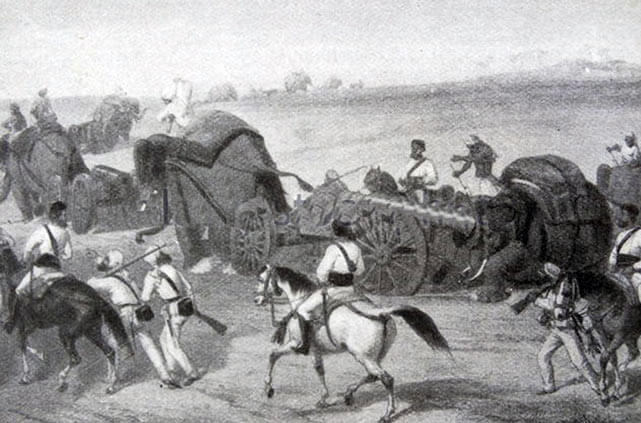
British/Bengali Army on the march: Battle of Ferozeshah on 22nd December 1845 during the First Sikh War
Each of the three presidencies, in addition to their native regiments, possessed European infantry, of which the 1st Bengal (European) Infantry, 2nd Bengal (European) Light Infantry and 1st Bombay (European) Fusiliers took part in the Sikh Wars.
Other corps fought under the British flag, such as the Shekawati cavalry and infantry and the first two Gurkha regiments: the Nasiri Battalion (later 1st Gurkhas) and the Sirmoor Battalion (later 2nd Gurkhas).
General Gough commanded the British/Indian army at 6 of the 7 major battles (not the Battle of Aliwal). An Irishman, Gough was immensely popular with his soldiers, for whose welfare he was constantly solicitous. The troops admired Gough’s bravery, in action wearing a conspicuous white coat, which he called his ‘Battle Coat’, so that he might draw fire away from his soldiers.
Gough’s tactics were heavily criticised, even in the Indian press in letters written by his own officers. At the Battles of Moodkee, Sobraon and Chillianwallah, Gough launched headlong attacks, considered to be ill-thought out by many of his contemporaries. Casualties were high and excited concern in Britain and India. By contrast, Gough’s final battle, Goojerat, which decisively won the war, cost few of his soldiers their lives and was considered a model of care and planning.
Every battle saw vigorous cavalry actions, with HM 3rd King’s Own Light Dragoons and HM 16th Queen’s Royal Lancers particularly distinguishing themselves. The British light cavalry wore embroidered dark blue jackets and dark blue overall trousers, except the 16th who bore the sobriquet ‘the Scarlet Lancers’ for their red jackets. The headgear of the two regiments of light dragoons was a shako with a white cover; the headgear of the lancers the traditional Polish tschapka.
HM regiments of foot wore red coats and blue trousers with shakos and white covers.
The Bengal and Bombay light cavalry regiments wore pale blue uniforms. The infantry of the presidency armies wore red coats and peak less black shakos.
The weapons for the cavalry were the lance for the lancer regiments and sword and carbine for all; the infantry was armed with the Brown Bess musket and bayonet.
Commands in the field were given by the cavalry trumpet and the infantry drum and bugle.
In the initial battles, the Sikh artillery outgunned Gough’s batteries. Even in these battles and in the later ones, the Bengal and Bombay horse and field artillery were handled with great resource and were a major cause of Gough’s success.
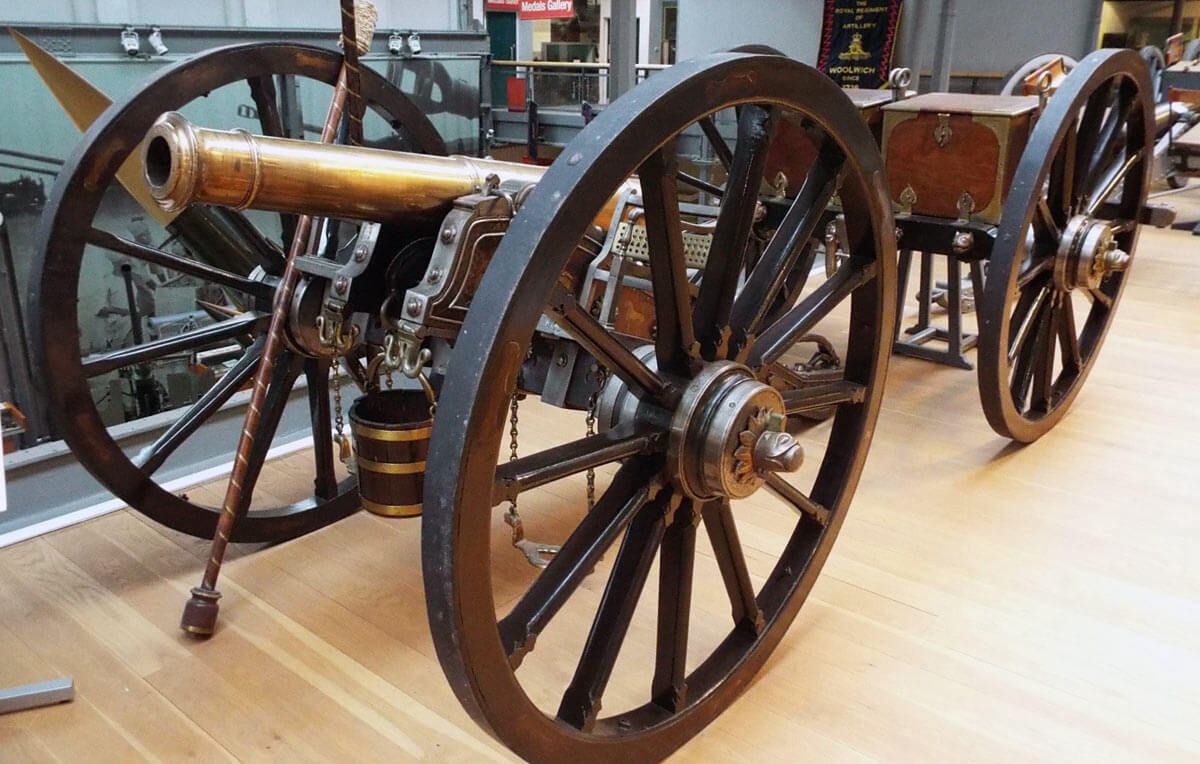
East India Company 9 pounder field gun: Battle of Ferozeshah on 22nd December 1845 during the First Sikh War: Firepower Museum
Many of the more senior British officers had cut their military teeth in the Peninsular War, and at the Battle of Waterloo: Gough, Hardinge, Havelock of the 14th Light Dragoons, Cureton, Dick, Thackwell and others. Many of the younger men would go on to fight in the Crimea and the Indian Mutiny.
The Sikhs of the Punjab looked to the sequence of Gurus for their spiritual inspiration, and had established their independence, fiercely resisting the Moghul Kings in Delhi and the Muslims of Afghanistan. The Sikhs were required by their religion to wear the ‘five Ks’, not to cut their hair or beard and to wear the highly characteristic turban, a length of cloth in which the hair is wrapped around the head.
The Maharajah of the Punjab, Ranjit Singh, whose death in 1839 ended the Sikh embargo on war with the British, established and built up the powerful Sikh Army, the ‘Khalsa’, over the twenty years of his reign. The core of the ‘Khalsa’ was its body of infantry regiments, equipped and trained as European troops, wearing red jackets and blue trousers. The Sikh artillery was held in high esteem by both sides. The weakness in the Sikh army was its horse. The regular cavalry regiments never reached a standard comparable to the Sikh foot, while the main element of the mounted arm comprised clouds of irregular and ill-disciplined ‘Gorcharras’.
The traditional weapon of the Sikh warrior is the ‘Kirpan’, a curved sword kept razor sharp and one of the ‘five Ks’ a baptised Sikh must wear. In battle, at the first opportunity, many of the Sikh foot abandoned their muskets and, joining their mounted comrades, engaged in hand to hand combat with sword and shield. Horrific cutting wounds, severing limbs and heads, were a feature of the Sikh Wars, in which neither side gave quarter to the enemy.
It had taken the towering personality of Ranjit Singh to control the turbulent ‘Khalsa’, he had established. Ranjit Singh’s descendants found the task beyond them and did much to provoke the outbreak of the First Sikh War, in the hope that the Khalsa would be cut down to size by the armies of the British East India Company. The commanders of the Sikh armies in the field rarely took the initiative in battle, preferring to occupy a fortified position and wait for the British and Bengalis to attack. In the opening stages of the war there was correspondence between Lal Singh and the British officer, Major Nicholson, suggesting that the Sikhs were being betrayed by their commander.
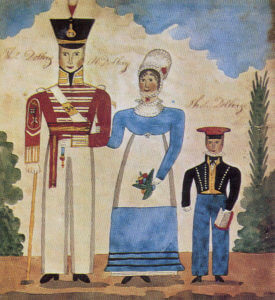
British soldier and his family: Battle of Ferozeshah on 22nd December 1845 during the First Sikh War
Pay in the Khalsa was good, twice the rate for sepoys in the Bengal Army, but it was haphazard, particularly after the death of Ranjit Singh. Khalsa administration was conducted by clerks writing in the Persian language. In one notorious mutiny over pay, Sikh soldiers ran riot looking for anyone who could, or looked as if they could, speak Persian, and putting them to the sword.
The seven battles of the war and the siege of the city of Multan were hard fought. Several of the battle fields were wide flat spaces broken by jungly scrub, from which the movement of large bodies of troops in scorching heat raised choking clouds of dust. As the fighting began, the dust clouds intermingled with dense volumes of musket and cannon smoke. With the thunder of gunfire and horses’ hooves, the battle yells and cries of the injured, the battles of the Sikh Wars were indeed infernos.
Winner of the Battle of Ferozeshah: The British and Bengali army, but only just. If Tej Singh had pressed his attack he was likely to have won the battle.
British and Indian Regiments at the Battle of Ferozeshah:
British:
HM 3rd King’s Own Light Dragoons, now the Queen’s Royal Hussars. *
HM 9th Foot, later the Norfolk Regiment and now the Royal Anglian Regiment.*
HM 29th Foot, later the Worcestershire Regiment and now the Worcestershire and Sherwood Foresters Regiment. *
HM 31st Foot, later the East Surrey Regiment and now the Princess of Wales’s Royal Regiment.*
HM 50th Foot, later the Queen’s Own Royal West Kent Regiment and now the Princess of Wales’s Royal Regiment.*
HM 62nd Foot, later the Wiltshire Regiment and now the Royal Gloucestershire, Berkshire and Wiltshire Regiment. *
HM 80th Foot, later the South Staffordshire Regiment and now the Staffordshire Regiment.*
Indian:
The Governor General’s Bodyguard.*
4th Bengal Light Cavalry.*
5th Bengal Light Cavalry.*
8th Bengal Light Cavalry.*
Skinner’s Horse.*
8th Irregular Cavalry.*
9th Irregular Cavalry.*
1st Bengal European Light Infantry.*
2nd Bengal Native Infantry.*
12th Bengal Native Infantry.*
14th Bengal Native Infantry.*
16th Bengal Native Infantry.*
24th Bengal Native Infantry.*
26th Bengal Native Infantry.*
33rd Bengal Native Infantry.*
42nd Bengal Native Infantry.*
44th Bengal Native Infantry.*
45th Bengal Native Infantry.*
47th Bengal Native Infantry.*
The Indian Army regiments:
Cavalry:
The Governor General’s Bodyguard continues as the President of India’s Bodyguard.*
Skinner’s Horse in 1861 became the 1st Bengal Cavalry, in 1903 the 1st Duke of York’s Own Lancers (Skinner’s Horse), in 1922 the 1st Duke of York’s Own Skinner’s Horse and from 1950 the 1st Horse of the Indian Army.*
8th Bengal Irregular Cavalry in 1861 became the 6th Bengal Cavalry, in 1906 the 6th King Edward’s Own Cavalry, in 1922 the 18th King Edward’s Own Cavalry and from 1950 the 18th Cavalry of the Indian Army.*
All the regular Bengal cavalry regiments that fought at Ferozeshah and 9th Irregular Cavalry ceased to exist in 1857.*
Infantry:
33rd Bengal Native Infantry in 1861 became 4th Bengal Native Infantry, in 1903 4th Prince Albert Victor’s Rajputs, in 1922 2nd Battalion (Prince Albert Victor’s) 7th Rajput Regiment and in 1950 2nd Battalion, the Rajput Regiment of the Indian Army.*
42nd Bengal Native Infantry in 1861 became the 5th Light Infantry and were disbanded in 1922.*
47th Bengal Native Infantry in1861 became the 7th Bengal Light Infantry, in 1903 7th Duke of Connaught’s Own Rajputs, in 1922 3rd Battalion (Duke of Connaught’s Own) 7th Rajput Regiment and in 1950 3rd Battalion, the Rajput Regiment of the Indian Army.*
The remaining Bengal infantry regiments that fought at Ferozeshah ceased to exist in 1857.
* These regiments have or had Ferozeshah as a battle honour.
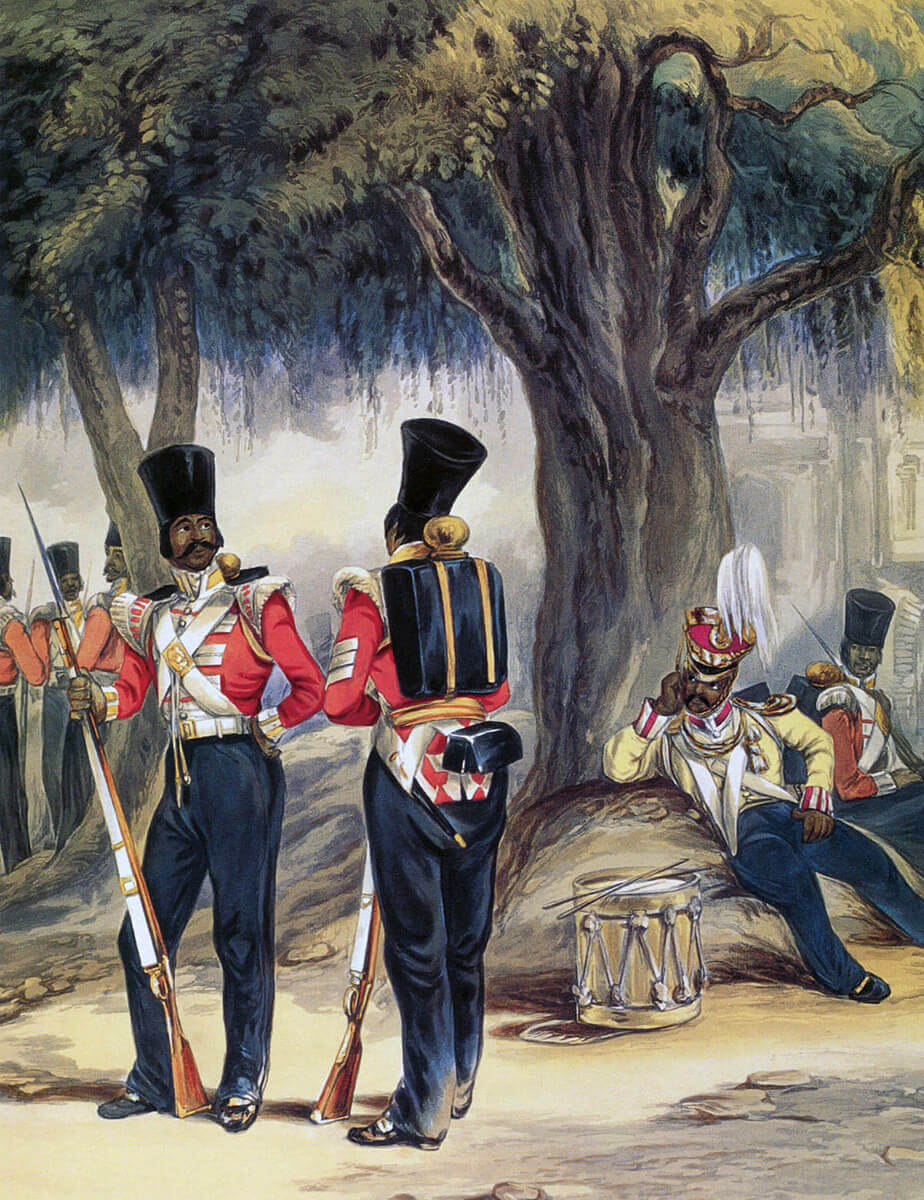
Bengal Native Infantry Regiment: Battle of Ferozeshah on 22nd December 1845 during the First Sikh War: print by Ackermann
The order of battle of the Army of the Sutlej at the Battle of Ferozeshah:
Commander-in-Chief: General Sir Hugh Gough.
Second in command: Sir Henry Hardinge, Governor General of Bengal.
The Cavalry Division:
First Brigade: Brigadier White; HM 3rd Light Dragoons, 4th and 9th Bengal Light Cavalry.
Second Brigade: Brigadier Gough; The Governor General’s Bodyguard and 4th Bengal Light Cavalry.
Infantry:
First Division: Major General Sir Harry Smith.
First Brigade: Brigadier Hicks; HM 31st Foot, 24th BNI and 47th BNI.
Second Brigade: Brigadier Ryan; HM 50th Foot, 42nd BNI and 48th BNI.
Second Division: Major General Sir Walter Gilbert.
Third Brigade: Brigadier Taylor: HM 29th Foot, HM 80th Foot and 41st BNI.
Fourth Brigade: Brigadier McClaren: 1st Bengal Europeans, 16th BNI and 45th BNI.
Third Division:
Brigadier General Wallace; HM 9th Foot and 73rd BNI.
Fourth Division: Major General Sir John Littler.
Seventh Brigade: Brigadier Reid; HM 62nd Foot, 12th BNI and 14th BNI.
Eighth Brigade: Brigadier Ashburnham; 33rd BNI, 44th BNI and 54th BNI.
Account of the Battle of Ferozeshah:
Following the Battle of Moodkee on 18th December 1845, Lal Singh’s force of Sikhs withdrew to Ferozeshah, eight miles to the north-west of the Moodkee battlefield, occupying strong fortified positions around the village of Ferozeshah.
While his British and Bengali troops dealt with the casualties from the Battle of Moodkee, General Gough sent instructions to General Littler, commanding the garrison in Ferozepore, to march out of the town, evading the blockading force of Tej Singh, and join him before Ferozeshah on 21st December 1845, for the second battle with Lal Singh’s force.
On the day after the Battle of Moodkee, reinforcements marched in from Ludhiana: HM 29th Foot, 1st Bengal Europeans and two regiments of Bengal Native Infantry with two howitzers.
Gough’s army was in place on the morning of the 21st December 1845, waiting for Littler. Gough decided to launch his attack without Littler’s men, but General Sir Henry Hardinge used his authority as Governor General to veto an attack, until the Ferozepore garrison arrived.
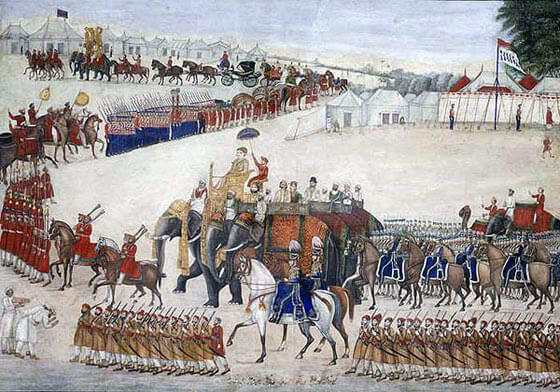
Military procession with a regiment of British Light Dragoons and British and Indian infantry: Battle of Ferozeshah on 22nd December 1845 during the First Sikh War
Littler arrived with two Bengal Light Cavalry regiments, HM 62nd Foot, five Bengal Native Infantry battalions, two troops of horse artillery and two field batteries at 1.30pm on 21st December, increasing Gough’s army to 18,000 troops and 65 guns. Littler’s division took up position on the extreme left of the line with his cavalry regiments in support.
At 3 pm on 21st December, with only two hours of daylight left, Gough opened the battle with an artillery bombardment, which the Sikhs answered vigorously. As in most of the early battles of the war, the Sikh artillery had the best of the exchange.
The fortifications around Ferozeshah comprised a series of trenches on a line of hillocks surrounding the village in a rectangle. The Sikh gunners manned some 100 good quality guns, that they served with skill and devotion. It is not known how many Sikhs were present in Ferozeshah, but they appear to have constituted a powerful force.
At around 3.30pm on 21st December 1845, Littler began an assault well in advance of the rest of the army, moving his guns forward to engage the Sikhs at closer range, his infantry regiments following in support. The infantry emerged into the open plain 300 metres from the Sikh line, and were met with a heavy fire of grapeshot from the Sikh guns (fragmented shot used on troops at close range to cause maximum casualties). The British 62nd Foot led the assault, losing 160 casualties in ten minutes. The regiment faltered and fell back, taking the native infantry regiments with them. Littler’s attack had failed.
As Littler began his attack, Gough ordered the rest of the British and Bengali infantry to assault the Sikh lines. The regiments pushed through the jungle under heavy artillery fire, emerging into the dense smoke and dust of the open plain, lit by the flashes of the Sikh gunfire.
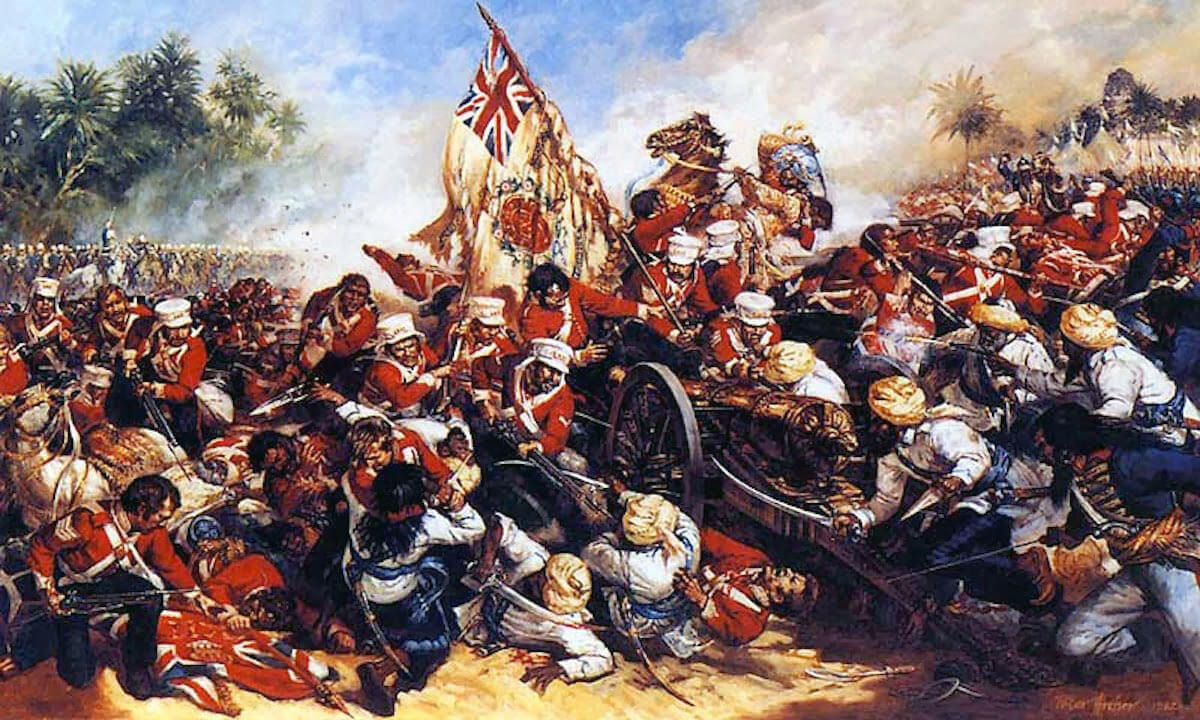
HM 29th Foot in the British attack on the Sikh Camp at the Battle of Ferozeshah on 22nd December 1845 during the First Sikh War
Part of the left of the British line faltered under the heavy fire, but HM 9th Foot and the right-hand division pressed on with the attack, while a brigade from the reserve, commanded by General Smith, moved forward to cover the gap left by the retreat of Littler’s brigade.
The attacking troops reached the Sikh entrenchments, pressed through, although suffering heavy casualties, and captured and spiked numbers of guns, before pushing on into the Sikh lines, which was quickly set on fire.
A large magazine in the Sikh camp exploded, causing considerable confusion and casualties. All over the camp, tents were ablaze, with stores of gunpowder exploding in the gathering dusk.
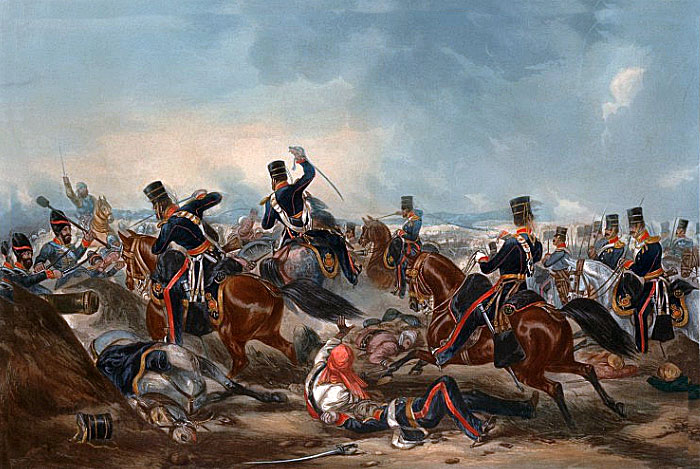
Attack of the British 3rd King’s Own Light Dragoons at the Battle of Ferozeshah on 22nd December 1845 during the First Sikh War: picture by Martens
On the right of the British line, Gough committed Brigadier White’s cavalry brigade; HM 3rd King’s Own Light Dragoons, 4th Bengal Light Cavalry (Lancers) and the 9th Bengal Irregular Cavalry, to an attack on the corner of the fortifications.
Considerably reduced by their casualties at Moodkee, the 3rd Light Dragoons charged through a battery and the infantry positioned behind it, before breaking into the Sikh camp and engaging in ferocious hand to hand combat with crowds of Sikh swordsmen and matchlock men.
General Smith, after fighting through the Sikh camp, found himself with a party of soldiers from his division on the far side of Ferozeshah, where he was attacked throughout the night by the Sikhs. He finally fought his way around the outside of the village to the south side, where he re-joined Gough and Hardinge as dawn broke.
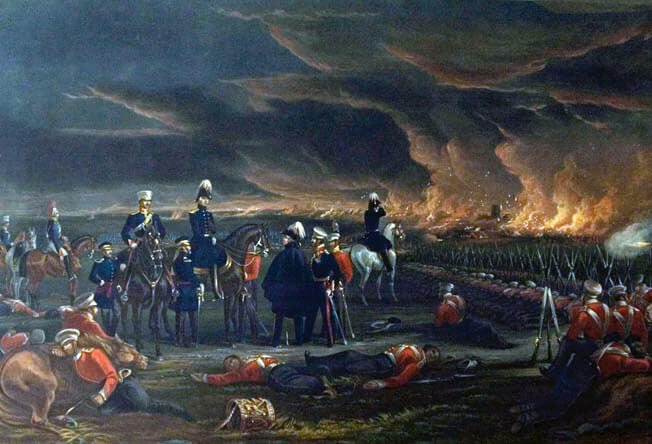
Night after the first day of the Battle of Ferozeshah on 22nd December 1845 during the First Sikh War
The fall of night forced the British and Bengali regiments to withdraw from Ferozeshah, abandoning the Sikh camp and fortifications, to pass the night as best they could among the casualties of the day’s fighting, under the renewed fire of the Sikh guns.
Gough and Hardinge spent the night in considerable anxiety, Hardinge making hasty arrangements to destroy his state papers, to prevent them from falling into Sikh hands in the event of a British defeat.
With dawn on 22nd December 1845, drums and trumpets signalled a renewed attack on the fortifications, but the Sikhs were falling back and Gough’s army quickly re-took Ferozeshah.
Battered and exhausted, the British and Bengali regiments ceased fighting, cheering Gough and Hardinge as they rode down the ranks, troopers carrying captured Khalsa flags.
But the battle was not finished. To the stupefaction of Gough’s men, onto the field marched the army of Tej Singh, the force that Littler had evaded in the previous days to escape from Ferozepore.
The British and Bengali troops were exhausted, their ammunition almost entirely expended. Gough occupied the Sikh fortifications, while a horse artillery battery engaged the Sikhs to keep them away for as long as possible. Then the line stood waiting for the Sikh attack, hardly expecting to be able to resist a determined assault.
Tej Singh’s artillery conducted a long and galling bombardment of Gough’s lines, followed by an advance of his cavalry against Gough’s right.
Gough ordered Brigadier White to attack the Sikhs, and, in one last effort, HM 3rd Light Dragoons, 4th Bengal Light Cavalry and 9th Bengal Irregular Cavalry urged their blown horses into the charge, causing Tej Singh to abandon his assault and withdraw from the battle field. The battle was finally over.
A curious incident occurred at the beginning of the day’s crisis, when the assistant adjutant-general, Major Lumley, suffering, it is thought, from the sun and the stress of battle, approached various regiments in turn and ordered them to march to Ferozepore, with the result that, at the worst moment of the hard-fought two-day battle, a significant portion of Gough’s army left the field. It may be that the sight of those forces marching away towards Ferozepore contributed to Tej Singh abandoning his attack and leaving the field.
The battle ended at around 4pm on 22nd December 1845, Gough and his army, now virtually without ammunition, reprieved from an attack that would have been hard to resist.
Casualties at the Battle of Ferozeshah: The casualties in the British and Bengali regiments were some 700 dead and 1,700 wounded, of which 1,207 were European, including 115 officers. Among the dead were several staff officers, including Major Broadfoot and Brigadier Taylor.
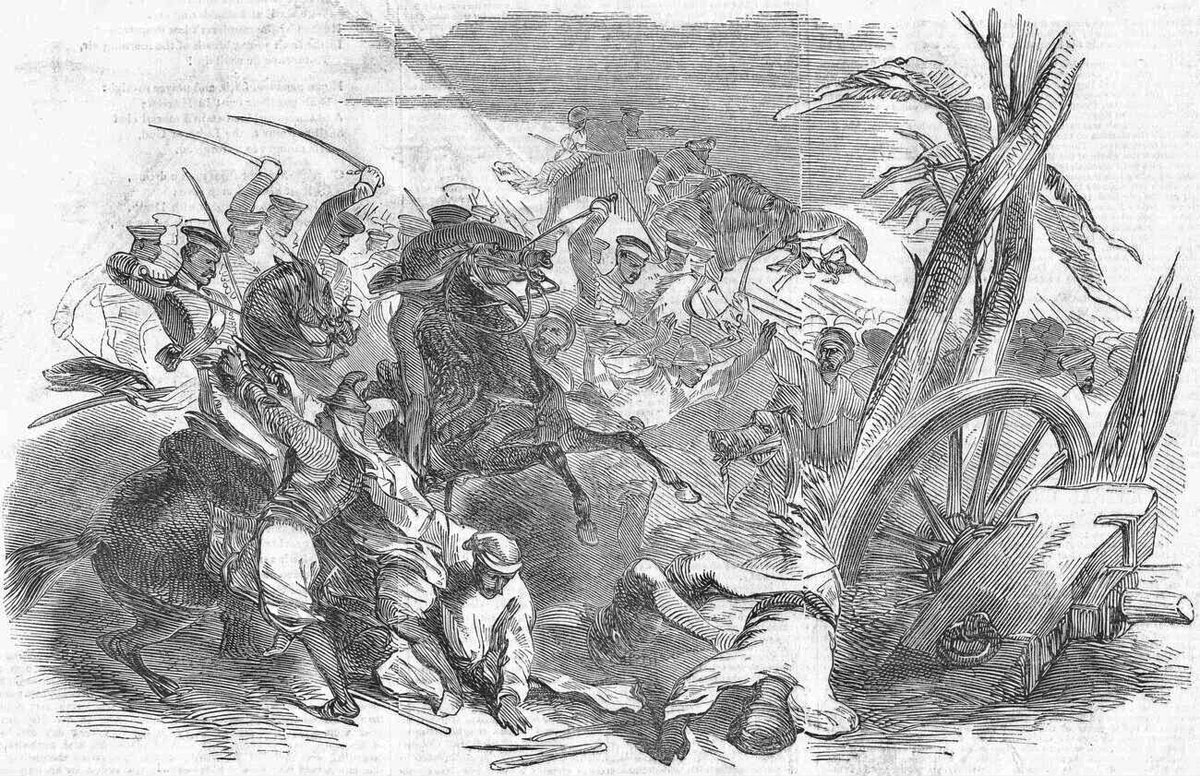
Charge of the Bengal Light Cavalry at the Battle of Ferozeshah on 22nd December 1845 during the First Sikh War
Regimental Casualties:
HM 3rd King’s Own Light Dragoons lost 152 men and 60 horses.
HM 9th Foot suffered 280 casualties.
HM 62nd Foot suffered 299 casualties.
HM 102nd Foot suffered 204 casualties.
HM 29th Foot suffered 184 casualties.
HM 31st Foot suffered 142 casualties.
HM 50th Foot suffered 124 casualties.
HM 80th Foot suffered 81 casualties.
1st Bengal (European) Light Infantry suffered 204 casualties.
Sikh casualties are thought to have been around 3,000. They lost 73 guns.
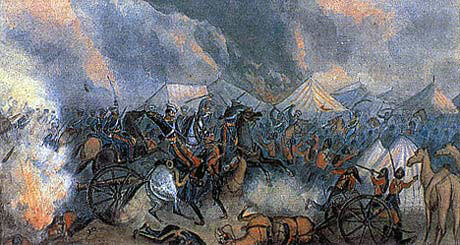
Attack of 3rd King’s Light Dragoons on the Sikh camp at the Battle of Ferozeshah on 22nd December 1845 during the First Sikh War
Follow-up to the Battle of Ferozeshah: After the battle, the Sikh army crossed the Sutlej at Sobraon, while Gough led his army on to Ferozepore, meeting there the demented Major Lumley and the regiments he had led from the field.
Only when reinforcements and additional ammunition arrived in the New Year would Gough resume his offensive and attack the main Sikh army in Sobraon.
Anecdotes and traditions from the Battle of Ferozeshah:
- HM 3rd King’s Light Dragoons made numerous charges in the three days of fighting at Moodkee and Ferozeshah, losing half their strength in casualties. At Ferozeshah, the 3rd performed the unusual feat for cavalry of charging fortifications and taking them. After the battle the Governor General, Sir Henry Hardinge, praised the regiment for their conduct.
- HM 62nd Foot suffered 7 officers killed and 11 wounded in the battle, leaving the regiment effectively without officers. It became a regimental custom, on the anniversary of the battle, to hand the colours to the care of the non-commissioned officers for 24 hours in commemoration.
- During the Battle of Ferozeshah, a particularly hard fought action took place over a black Akali standard, with several officers and soldiers of HM 80th Foot killed in the struggle to capture it. The standard was finally taken by Colour Sergeant Kirkland of HM 29th Foot and now hangs in Litchfield Cathedral.
- When news of the Battle of Ferozeshah reached London, the Prime Minister Sir Robert Peel talked of a Pyrrhic victory. The Duke of Wellington said ‘Gough has lost a good many men; but what of it? You must lose officers and men, if you have to fight a great battle. At Assaye I lost a third of my force.’
- Present with the British generals at the beginning of the Battle of Ferozeshah was Prince Waldemar of Prussia, son of the King of Prussia and colonel of the Prussian Guard Dragoons. One of the prince’s companions, Herr Hoffmeister, was killed during the fighting. At the end of the first day, fearing that the Sikhs would win the battle when it was renewed the next day, Sir Henry Hardinge sent the prince to the rear, out of harm’s way.
- Sir Henry Hardinge ensured that 1,000 mince pies were distributed to the British troops on Christmas Day 1845.
- The Sikhs mined their camp, so that casualties were caused to the British and Bengali soldiers as they ransacked the tents.
- Many of the captured Sikh guns were brass and decorated with Persian inscriptions.
- Although threatened with trial by court martial, Major Lumley, the assistant adjutant general who ordered several regiments to leave the battlefield at the moment of crisis, as Tej Singh’s army marched up, was medically discharged and sent home.
- Several British regiments commemorate the Battle of Ferozeshah: the 62nd, which became the Wiltshire Regiment and the 80th, which became the South Staffordshire Regiment. The successors of both these regiments continued to mount parades on the anniversary of the battle. In the Wiltshire Regiment the colours were handed to two sergeants, who held them for 24 hours in commemoration of the high officer casualties at Ferozeshah, which led to the colours being taken over by sergeants.
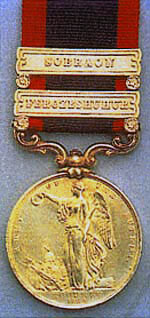
Sutlej Campaign, 1845-6 Medal with clasp for the Battle of Ferozeshuhur on 22nd December 1845 during the First Sikh War
Medals and decorations: British and Indian soldiers who took part in the First Sikh War received the medal entitled ‘Sutlej Campaign, 1845-6’.
Where a soldier took part in one or more battles, his medal would have the first battle inscribed on the reverse side of the medal and the remaining battles on clasps on the ribbon.
The battles being described as: ‘Moodkee 1845’, ‘Ferozeshuhur 1845’, ‘Aliwal 1946’ and ‘Sobraon 1846’.
Description of the medal:
Obverse. -Crowned head of Queen Victoria. Legend: ‘Victoria Regina.’
Reverse. -Victory standing beside a trophy, holding a wreath in her outstretched hand. Inscription: ‘Army of the Sutlej.’
Mounting. -Silver scroll bar and swivel.
Ribbon: Dark blue with crimson edges. 1 ¼ inches wide.
References for the Battle of Ferozeshah:
History of the British Army by Fortescue.
History of British Cavalry by the Marquis of Anglesey.
The previous battle in the First Sikh War is the Battle of Moodkee
The next battle in the First Sikh War is the Battle of Aliwal
